Tubman and Montgomery planned the route and other details of the raid, enlisting the help of local Black watermen who were intimately familiar with the river and its connecting tributaries. Operating under the cover of darkness, the raid was launched from Port Royal with three vessels – the John Adams, the Harriet A. Weed, and the Sentinel – transporting about three hundred infantrymen and a small group of soldiers to handle the artillery on the boats. By dawn on June 2, 1863, the small flotilla reached its objective twenty-five miles upriver from the coast and in the heart of a Confederate supply station which was their goal.
Operating with speed and stealth, the raiding party confiscated rice, corn, cotton, and horses along with various farm animals. What stores the Union Army could not transport were destroyed, thereby denying their use by the Confederates. Other actions were taken to disable Rebel infrastructure in the area. Tubman was asked to help encourage enslaved people in the vicinity to leave the farms and plantations where they were living. According to accounts that followed, 730 liberated enslaved people were taken away in the three Union vessels.
An eyewitness from the Wisconsin State Journal wrote: “The black woman [Tubman] who led the raid, and under whose supervision it was originated and conducted, addressed the group and the words she spoke would do honor to any man, and it created quite a sensation.” The article concluded by reporting: “Colonel Montgomery and his gallant band of 300 black soldiers, under the guidance of a black woman, dashed into the enemies’ country, struck a bold and effective blow, destroying millions of dollars’ worth of commissary stores, cotton, and lordly dwellings and struck terror to the heart of a rebellion, brought off nearly 800 slaves and thousands of dollars’ worth of property without losing a man or receiving a scratch! It was a glorious consummation.”
This surgical strike up the Combahee River by Montgomery’s “fleet” in coastal South Carolina infuriated the Confederate leadership which characterized it as a wanton act of destruction and pillaging. Their reaction might have been further inflamed had they known the raid was carried out by three hundred African-American Union soldiers and a formerly-enslaved Black woman. Harriet Tubman was especially pleased that the raid demonstrated Black soldiers could conduct themselves with bravery and honor on the field of battle.
Woodcut of Harriet Tubman from Sarah H. Bradford’s Scenes in the Life of Harriet Tubman, 1869.
Source from The Better Angels: Five Women Who Changed Civil War America, University of Nebraska Press, 2020.

Recent Comments